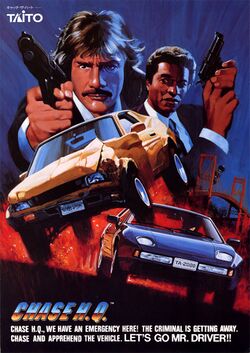m (Update infobox) |
(Revised intro) |
||
| Line 17: | Line 17: | ||
{{marquee|Chase H.Q. marquee.jpg}} | {{marquee|Chase H.Q. marquee.jpg}} | ||
'''Chase H.Q.''' is a [[ | {{nihongo|'''Chase H.Q.'''|チェイスH.Q.||"Chase Headquarters"}} is a vehicular combat racing game, originally released as an [[arcade]] game by [[Taito Corporation]] in [[1988]]. It is sometimes seen as a spiritual successor to Taito's earlier [[Full Throttle]]. The player assumes the role of a police officer named Tony Gibson, member of the "Chase Special Investigation Department". Along with his partner, Raymond Broady, he must stop fleeing criminals in high-speed pursuits in a black Porsche 928. | ||
Chase H.Q. was ported to many home computers by [[Ocean Software]] in 1989, including versions for the [[ZX Spectrum]], [[Amstrad CPC]], [[Commodore 64]], [[MSX]], [[Amiga]] and [[Atari ST]]. Taito produced versions for the [[Famicom]] (1989), [[Game Boy]] (1990), [[Master System]] (1990), [[TurboGrafx-16]] (1990), [[Game Gear]] (1991) and [[Saturn]] (1996). It was released for [[PlayStation 2]] in Japan in 2007 as part of [[Taito Memories II Gekan]]. | |||
The game was a commercial success, becoming Japan's highest-grossing dedicated arcade game of 1989 while also becoming a hit overseas for arcades and home systems. The game was also well received by critics. It was followed by three arcade-based sequels: [[Special Criminal Investigation]] (1989), [[Super Chase: Criminal Termination]] (1992) and [[Chase H.Q. 2]] (2007). Two spin-offs were also released: [[Crime City]] (1989) and [[Quiz H.Q.]] (1990). | |||
<gallery> | <gallery> | ||
File:Chase H.Q. upright cabinet.jpg|Upright arcade cabinet. | File:Chase H.Q. upright cabinet.jpg|Upright arcade cabinet. | ||
File:Chase H.Q. sitdown cabinet.jpg|Sitdown arcade cabinet. | File:Chase H.Q. sitdown cabinet.jpg|Sitdown arcade cabinet. | ||
File:Chase H.Q. Porsche sitdown cabinet.jpg|Porsche sitdown cabinet. | File:Chase H.Q. Porsche sitdown cabinet.jpg|Porsche sitdown cabinet. | ||
</gallery> | |||
<gallery> | |||
File:Chase H.Q. title screen.png|The game's title screen. | |||
File:Chase H.Q. high score table.png|Default high score table. | File:Chase H.Q. high score table.png|Default high score table. | ||
File:Chase H.Q. gameplay.png|Screenshot of the game. | File:Chase H.Q. gameplay.png|Screenshot of the game. | ||
Latest revision as of 01:17, 20 April 2023
This is the first game in the Chase H.Q. series. For other games in the series see the Chase H.Q. category.

| Chase H.Q. | |
|---|---|
| Developer(s) | Taito Corporation |
| Publisher(s) | Taito Corporation |
| Year released | 1988 |
| System(s) | Arcade, Sinclair ZX Spectrum, Amstrad CPC, Commodore Amiga, Atari ST, NES, TurboGrafx-16, Sega Master System, Commodore 64/128, Game Boy, Sega Game Gear, Sharp X68000, FM Towns, Game Boy Color |
| Followed by | S.C.I. - Special Criminal Investigation |
| Series | Chase H.Q. |
| Japanese title | チェイスH.Q. |
|---|---|
| Genre(s) | Racing |
| Players | 1 |
| Modes | Single player |
Chase H.Q. (チェイスH.Q.? "Chase Headquarters") is a vehicular combat racing game, originally released as an arcade game by Taito Corporation in 1988. It is sometimes seen as a spiritual successor to Taito's earlier Full Throttle. The player assumes the role of a police officer named Tony Gibson, member of the "Chase Special Investigation Department". Along with his partner, Raymond Broady, he must stop fleeing criminals in high-speed pursuits in a black Porsche 928.
Chase H.Q. was ported to many home computers by Ocean Software in 1989, including versions for the ZX Spectrum, Amstrad CPC, Commodore 64, MSX, Amiga and Atari ST. Taito produced versions for the Famicom (1989), Game Boy (1990), Master System (1990), TurboGrafx-16 (1990), Game Gear (1991) and Saturn (1996). It was released for PlayStation 2 in Japan in 2007 as part of Taito Memories II Gekan.
The game was a commercial success, becoming Japan's highest-grossing dedicated arcade game of 1989 while also becoming a hit overseas for arcades and home systems. The game was also well received by critics. It was followed by three arcade-based sequels: Special Criminal Investigation (1989), Super Chase: Criminal Termination (1992) and Chase H.Q. 2 (2007). Two spin-offs were also released: Crime City (1989) and Quiz H.Q. (1990).
-
Upright arcade cabinet.
-
Sitdown arcade cabinet.
-
Porsche sitdown cabinet.
-
The game's title screen.
-
Default high score table.
-
Screenshot of the game.





